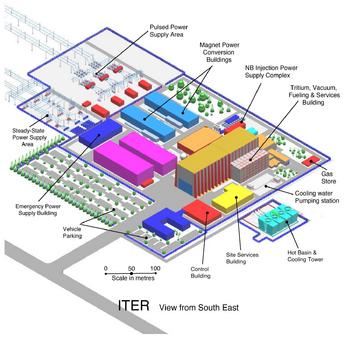Almost 20 years into the project, after various countries have joined, left and rejoined, and after 18 months of debate on the final two siting options, it was finally announced that the International Thermonuclear Experimental Reactor (Iter) is to be built in the European Union’s (EU’s) choice location, Cadarache in France.
The rejected site, Rokkasho in Japan, wins the consolation prize of a vital materials testing facility and a large share of the research work as part of a ‘privileged partnership’.
During the 18 months of negotiations, both the EU and Japan were insisting that their candidate locations would be chosen. The project’s six member countries were evenly divided: China and Russia backed the EU while South Korea and the USA backed Japan.
INTERNATIONAL REACTION
Favourable terms for Japan include that the EU will pay half the construction cost of the materials facility, to be built at Rokkasho. Japan will also get about 20% of the project’s 200 research posts and the position of director general although it will pay only 10% of the overall project cost. The EU will pay 50% of the construction costs of Iter itself and 10% of that budget will be spent with Japanese firms. Other member countries will pay 10%.
Soon after the siting announcement, India’s Department of Atomic Energy wrote to the European Commission to express its interest in joining the Iter project. Anil Kakodkar, chairman of India’s Atomic Energy Commission, called for a meeting with the Iter partners in order to discuss the possibility of joining as a full partner, in which it would provide a substantial contribution.
India already has several fusion research projects underway including experimental tokamak devices like ADITYA and SST 1. India has long been rumoured to be interested in joining the project, but had been prevented from doing so for over a year because of the siting impasse. Now that issue has been settled, the way should be clear for the country’s participation.
Meanwhile, China has announced that it intends to develop fusion technology on its own, despite already being a member of the Iter project. The country plans to take data from the project to build its own fusion facility.
BIG BIG BIG SCIENCE
The r10 billion scientific project, second only to the International Space Station in budget terms, has achieved mythical status. It took 19 years and 344 days to reach this point since the start of Iter discussions – and of course, fusion power has been consistently predicted to be about 40 years away since the 1950s.
Iter will be a tokamak fusion reactor that should be capable of producing a sustained 500MW of thermal power. Its plasma volume of 837m3 will be five times that of the UK’s Joint European Torus (JET) – currently the largest tokamak in the world – which can sustain plasma shots of a few megawatts for a few seconds; Iter is hoped to achieve stable plasmas lasting about two weeks.
Construction should begin this year and be completed by 2015. After that the reactor should operate for another 21 years, during which fusion scientists hope to learn enough to design a demonstration power plant (already named Demo). If Iter’s dimensions could be increased by 15% and plasma density 30% it is thought that Demo could contain about four times Iter’s thermal power and be made to give something like 500MW net electrical power.
The EU has agreed to support any Japanese bid to host Demo but that would only come in about 2030, assuming the Iter project finds solutions to operational and materials problems such as developing a blanket to bombard with fusion neutrons in order to breed tritium for use as fuel. This must be done in such a way that does not overly contaminate any future power production coolant.
The Rokkasho materials testing facility will be vital to the overall fusion project. Certain low activation steels were under consideration for Iter’s construction but there was not sufficient data on their performance from other nuclear environments to satisfy regulators of their safety for Iter. Only stainless steel with an austenitic crystal form, as widely used in fission programmes, has sufficient data to qualify for use, and even that would soon become brittle beyond Iter’s operational lifetime. New materials must be qualified for use in Demo by 2025 – the time pencilled in for the start of construction.




